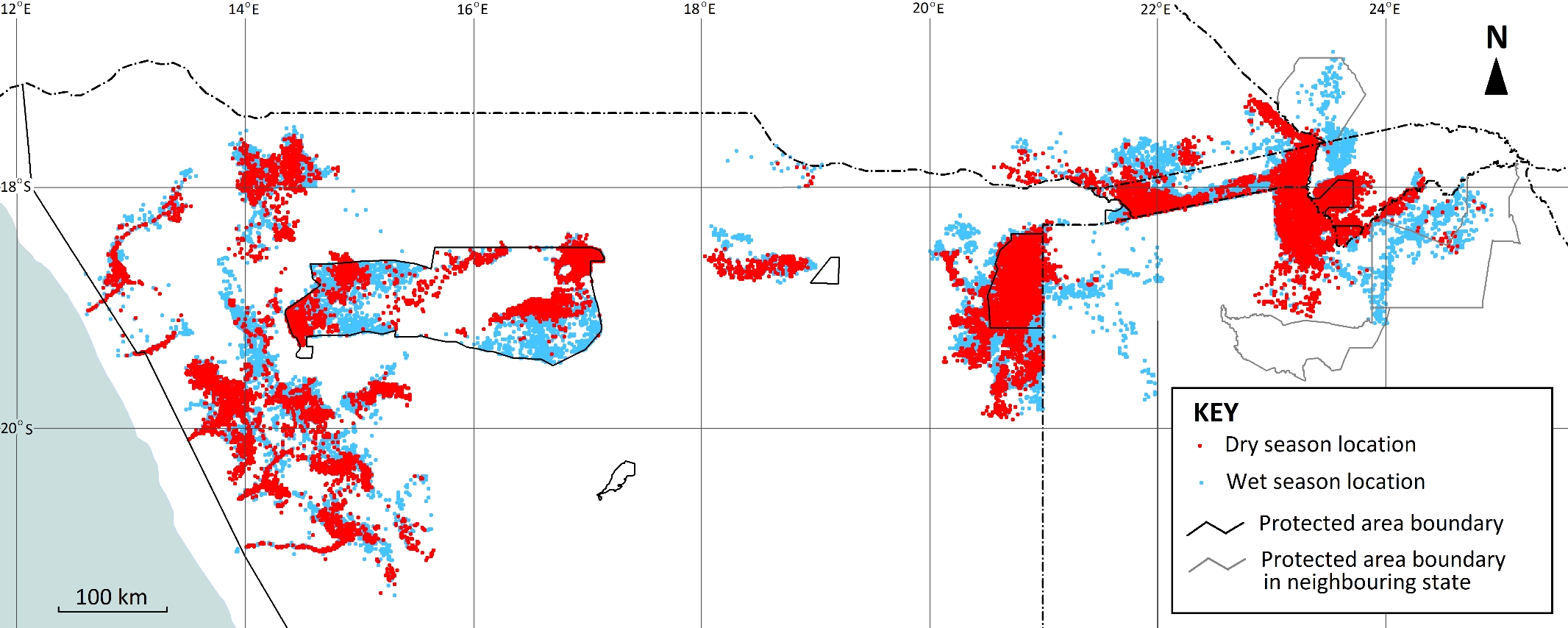Namibia's elephants—population, distribution and trends
DOI:
https://doi.org/10.69649/pachyderm.v62i.460Abstract
Namibia’s elephants extend across the north of the country. They occur in six main areas of the known Namibian range—the north-west, Etosha National Park (NP), Mangetti National Park, northern Kavango, Khaudum National Park/Nyae Nyae Conservancy and Zambezi Region. Seasonal changes in distribution are related to water availability. There are movements of elephants between Namibia and its neighbours, particularly Botswana, and mainly from Zambezi Region. The largest populations are found in the north-east of the country, in Khaudum/Nyae Nyae and Zambezi Region. Densities are very low in the extremely arid north-west and Etosha NP but have recovered from historical over-hunting that almost exterminated them.
The estimated rate of change for the north-west population is 3.86% per annum between -0.08% and 7.95%), which is not statistically significant. Since 1998, surveys have shown that the elephant population has been increasing slowly in Etosha NP at an estimated annual rate of 1.75% (between 0.65% and 2.87%). The trend is statistically significant. There has been a consistent and significant increase in the Zambezi population at an estimated and biologically realistic annual rate of 4.76% (between 2.73% and 6.84%) since 1995. This trend is statistically very highly significant. The population of elephants in Khaudum NP and Nyae Nyae Conservancy has increased at a very highly significant rate of 4.85% (between 3.24% and 6.48%).
As a total population, Namibia’s elephants have been increasing at a rate of 5.36% (between 4.20% and 6.53%) since 1995. This is also statistically very highly significant.
Résumé
Les éléphants de Namibie sont présents dans tout le nord du pays. Ils sont répartis dans six zones principales de l'aire de répartition namibienne connue: le nord-ouest, le parc national d'Etosha, le parc national de Mangetti, le nord de Kavango, le parc national de Khaudum/Nyae Nyae Conservancy et la région de Zambezi. Les changements de cette distribution selon les saisons sont liés à l’existence d'eau. Il y a des mouvements d'éléphants entre la Namibie et ses voisins, en particulier le Botswana, et principalement depuis la région de Zambezi. Les populations les plus importantes se trouvent dans le nord-est du pays, dans la région de Khaudum/Nyae Nyae et de Zambezi. Les densités sont très faibles dans les zones extrêmement arides du nord-ouest et d’Etosha, mais se sont rétablies de la sur-chasse historique qui les a presque exterminés.
Le taux de changement estimé pour la population du nord-ouest est de 3,86 % par an (entre - 0,08 % et 7,95 %), ce qui n'est pas statistiquement significatif. Depuis 1998, des enquêtes ont montré que la population d'éléphants augmente lentement dans le parc national d'Etosha à un taux annuel estimé à 1,75 % (entre 0,65 % et 2,87 %). La tendance est statistiquement significative. Il y a eu une augmentation constante et significative de la population de Zambezi à un taux annuel estimé et biologiquement réaliste de 4,76 % (entre 2,73 % et 6,84 %) depuis 1995. Cette tendance est statistiquement très significative. La population d'éléphants du parc national de Khaudum et de la réserve de Nyae Nyae a augmenté avec un taux très hautement significatif de 4,85 % (entre 3,24 % et 6,48 %).
En tant que population totale, les éléphants de Namibie ont augmenté à un taux de 5,36 % (entre 4,20 % et 6,53 %) depuis 1995.

Downloads
Published
How to Cite
Issue
Section
License
Copyright (c) 2021 Pachyderm

This work is licensed under a Creative Commons Attribution-NonCommercial 4.0 International License.



